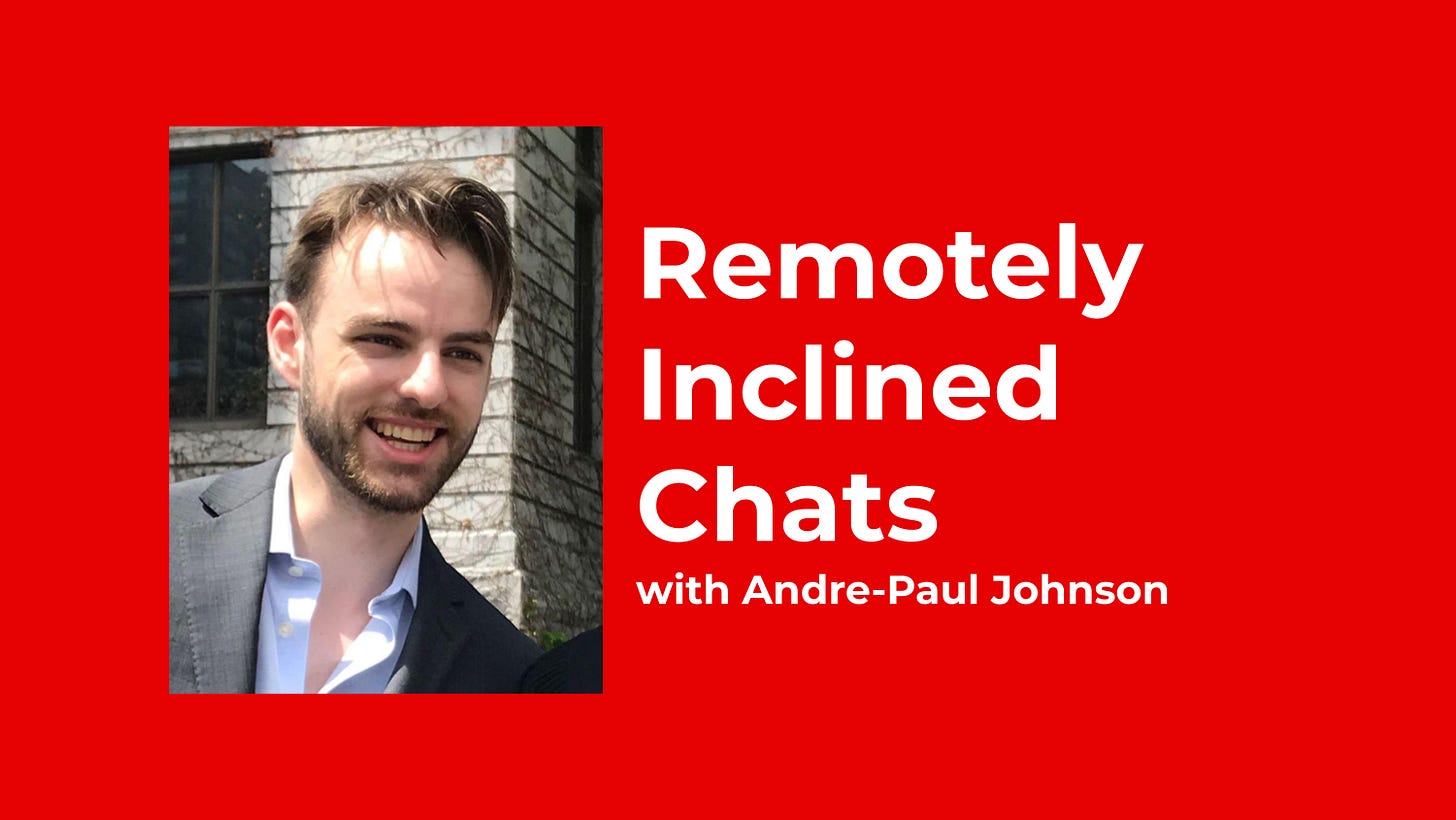Hi,
Welcome to Remotely Inclined, a newsletter about running a business remotely. If you’d like to sign up, you can do so here. Want to share your feedback? Take this short survey. Or just read on…
As this audience is well aware, I’m pro-remote work. But I also don’t pretend it’s the solution to every work problem. In previous Remotely Inclined Chats episodes, I’ve talked with leaders about the ways that remote work isn’t perfect - or ways it’s downright annoying. For Floyd Marinescu at C4 Media, it was around creativity. For Andrew D’Souza at Clearbanc, it was about culture.
Andre-Paul Johnson, the head of growth at Breaking Walls, is also pro-remote, and has been working remotely on and off for a decade. He even left Breaking Wall’s Montreal office to work remotely from Jamaica in 2019. He also writes a newsletter about remote growth. But despite its benefits, he noticed a key weak point in remote work, and that’s what we talked about on this edition of Remotely Inclined Chats.
So whether you’re pro-remote and want to avoid a serious pitfall or hate remote work and want some schadenfreude, keep reading.
A hybrid failure
→ As more companies announce their post-COVID remote plans, the vast majority are picking a hybrid arrangement. People often think that a hybrid arrangement with some in-office employees and some remote employees is the best of both worlds. In Andre-Paul’s experience, it could end up being the worst of both worlds instead.
→ When companies have a hybrid approach to remote work, a two-tiered culture can appear. Suddenly, a lot of work gets done in the office that remote workers don’t see, and vice versa. In Andre-Paul’s experience, companies will often default to the culture and communication style of the founders and leaders. However, in-office employees benefit from good remote cultures while remote workers don’t benefit from in-office cultures. So there’s a disconnect if leadership or company founders work in offices.
→ A key issue Andre-Paul noticed in his hybrid remote arrangement as asymmetric information flows. When you aren’t in the office, you don’t see what people are casually working on and you don’t have random ‘collisions.’ This isn’t as much of a problem in all-remote environments, since information flows become entirely virtual. It’s a significant challenge in hybrid environments since a lot of work happens that isn’t documented when you’re in an office, leaving out remote workers.
Liking this newsletter? I’d be grateful if you shared with with a friend, colleague, or on your social networks
Seeing the trees and the forest
→ Addressing this challenge, for Andre-Paul, was a matter of communicating in the open as much as possible. When work is documented (a regular management best practice), then it doesn’t matter where the work happens. For this to be successful, leaders of hybrid teams have to default to virtual information sharing regardless of if work is done in an office or remotely.
→ One solution that Andre-Paul particularly liked was Quora’s announcement about going “remote-first.” While employees can choose whether to work remotely or come into the office, all of Quora’s leadership must be remote. This will keep information and culture flows happening virtually, so both remote and in-office employees can plug into what’s going on.
→ Despite the negatives he experienced, Andre-Paul is still pro-remote. He sees the benefits of location freedom and building deep relationships with people online as well worth the nuisances of asymmetric information and broken information flows.
The final word
“The thing with remote is that it’s not that different, in the end, from in-person management.”
Not already a subscriber? Join 550+ other smart people getting insights on running a business remotely.
Remotely Inclined Chats with Andre-Paul Johnson
Transcript edited for brevity and clarity.
Stefan: Welcome, Andre-Paul! Tell me what you’re up to at Breaking Walls.
Andre-Paul: Breaking Walls is a video startup based in Montreal. I’m the head of growth on our small team. My job is to make sure whatever our devs are making ends up in people’s hands. That means a lot of things when you’ve got a small team - but it’s one of the cool parts of the job since you get to touch a lot of different aspects of the business.
You went remote for love. What happened?
I’ve been working remotely on an off for the past 10 years on a wide variety of products, small teams, big teams, some hybrid, and some fully distributed. I’ve kind of run the gamut of what it’s like to work remotely.
But this past year and a half has been extra unique. Our team is based out of Montreal. I used to live in Montreal. Then early 2019 I moved to Jamaica to be closer to my girlfriend, which is a pretty big move. A big part of that also meant a lot had to change with how I did my job because our team was co-located. We still had the office in Montreal. Working as the lone remote work on the team means you need to implement new processes and adapt how you work to the new situation. Luckily for me I was able to be in a job that allowed me to work remotely.
I’ve always wanted to travel, so I took the plunge. About a year and a half of travelling later, I’m back in Canada but still working remotely - currently based out of Toronto with the team still in Montreal. And now, of course, everyone is remote due to COVID. That has added a new dynamic to the team.
You said that hybrid remote work is like the worst of both worlds. Can you elaborate on that?
One of the big issues with hybrid remote work is managing the flow of information in a way that seems fair to everybody. Typically in a co-located team, or a team where everybody’s in the office, all the conversations happen in person: information exchange and information flows.
It also all happens in the same place in fully distributed teams - all online, on Zoom, or in Slack.
But when you have a team that has both people in an office and people working remotely, you end up with a fragmented flow of information. Oftentimes that flow of information happens wherever the leadership team is. I can tell you from experience that most leadership teams on hybrid teams end up in the office. So what that means is everyone in the office has access to those informal conversations with the leadership team. They’re privy to the decisions being made and the processes behind those decisions. Meetings happen in the office and remote colleagues aren’t included, or it’s an afterthought.
People who work remotely on hybrid teams often end up feeling like second-class citizens within their own team. And that impacts not only team productivity but team morale. And the result is a lot of hybrid remote teams don’t perform up to the level that they could, and there are different ways to mitigate that.
How did you mitigate these challenges?
Before jumping into what I did, one thing I read recently is what Quora did when they announced they were going hybrid remote-first. They’re allowing anybody to work remotely while keeping headquarters open to anyone who wants to come into the office.
But what their CEO did that I think is brilliant is that he said the leadership team has to work remotely. As I mentioned, the information flow happens wherever the leadership team is. And in this case, leadership is remote. So the information flow would happen online. If people chose to work in the office, they still have to log into meetings through their own video chat and camera.
Everybody ends up on equal footing and there’s nobody who is at an unfair advantage over other people in the company. And I think that is an extremely thoughtful way of implementing hybrid remote work in a way that actually works for your team and allows your team to remain productive and everybody feel valued.
In terms of information flow stuff I’ve done with my team, we’ve been working on a lot of challenges that remote work has. I think a lot of remote managers will be able to relate with this.
If you look at teams in an office, a lot of information flows relatively freely and you don’t even realize it. Informal conversations, team lunches, looking over at someone’s computer, or even just the physical space element of knowing someone is there if you need help. On top of that, you get body language, which is huge. It has its pitfalls, but a big advantage is that all the information flows freely and you can get away with a lack of structure and poorly defined processes since so much information is implicit.
With a remote team, there’s basically no implicit information exchange. It’s harder to build trust and harder to empower teammates or get timely feedback.
Here’s what we’ve done in our teams over the years to try to fix these issues:
Over communicate: you have to communicate absolutely everything. Every decision that gets made. Every conversation. You have to make sure nothing is left to chance and make sure all information is conveyed explicitly so expectations are set properly.
Document: it’s not only communicating, but making sure that everything gets documented. We have meeting logs for every meeting, which I know a lot of teams do in-office but it’s crucial to do that on remote teams. Same thing with decision logs, making sure that the reasoning behind every decision is documented.
But even with communication and documentation, it’s harder to build trust with your team. It becomes a challenge because all communication ends up being very intentional and explicit. You lose those serendipitous moments of running into a colleague or going out for lunch or drinks. You have to plan for everything.
On our team, we’ve started making room for non-work bonding. That means anything from a daily non-work video chats (or weekly) to talk about anything and get to know each other as people. We also have informal Slack channels or activities like book clubs or movie nights, or even team offsites (in non-COVID times).
How do you balance getting work done and travelling?
A big part of that comes down to how your team structures work. I’m on a team that allows a lot of asynchronous work from the get-go. Our team has synchronous periods, like working at similar times, but people will come into the office at different times during the day or something like that.
In remote teams, it’s a great opportunity to take this to the next level and try to find the right mix between synchronous and asynchronous work.
That way, unless we had scheduled meetings or other scheduled activities, I’m free to make my own schedule. And that freedom makes a huge difference in team productivity. On the flip side, asynchronous work has its pitfalls as it’s harder to build trust or culture, but that’s where synchronous communication and synchronous work comes in.
In my experience, 30% synchronous and 70% asynchronous time seems to work really well. We don’t measure exactly, but that’s approximately how we’ve done it with our team for the past couple years.
What’s your advice for a remote leader struggling to build information and trust systems remotely?
The thing with remote is that it’s not that different, in the end, from in-person management. Management always comes down to giving space to your best people to do their best work, and making sure you facilitate information flow within the team.
So whatever you can do to improve that on your team, wherever your feel your team is lacking, it’s your job as a manager to facilitate a solution. A lot of the time that is the same in a remote setting as it is in a non-remote setting. It’s much harder than it sounds, but it’s as simple as that.
Amazing, thank you for your insights!
You can get in touch with Andre-Paul on Twitter or on his newsletter.















"It’s The Worst Of Both Worlds": Solving Remote Work’s Weak Point